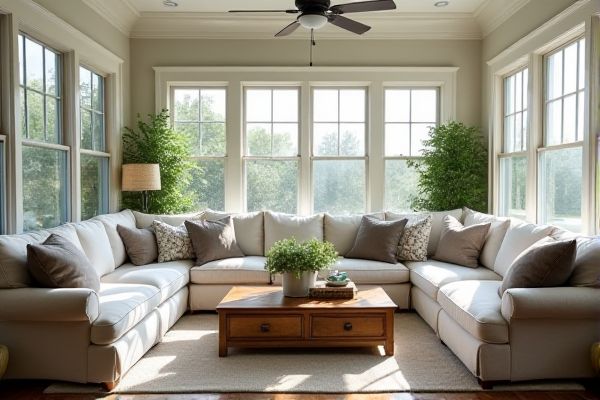
L-shaped sunroom sofas maximize corner space, offering a cozy seating arrangement ideal for small to medium-sized sunrooms. U-shaped sofas provide more expansive seating with a sociable layout for larger sunrooms, enhancing comfort and interaction during gatherings--explore the rest of the article to discover which design suits your sunroom best.
Table of Comparison
| Feature | L-Shaped Sunroom Sofa | U-Shaped Sunroom Sofa |
|---|---|---|
| Seating Capacity | 3-5 people | 5-7 people |
| Space Requirement | Compact, fits smaller sunrooms | Requires larger sunroom space |
| Design Style | Modern and minimalistic | Cozy and communal |
| Comfort | Good corner support | Encourages social interaction |
| Placement Flexibility | Easy to position in corners | Best for central or open layouts |
| Cost | Generally more affordable | Higher price due to size |
| Popular Use | Small to medium sunrooms | Large sunrooms or open spaces |
Introduction to Sunroom Sofas: L-Shaped vs U-Shaped
L-shaped and U-shaped sunroom sofas offer distinct seating arrangements tailored to different space and social needs. L-shaped sofas maximize corner areas, providing ample seating while maintaining open pathways, ideal for smaller sunrooms or those seeking a modern, streamlined look. U-shaped sofas create a more inclusive and conversational environment, perfect for larger sunrooms with frequent gatherings and a desire for cozy interaction.
Space Optimization: Which Shape Fits Your Sunroom Best?
An L-shaped sunroom sofa maximizes corner space, making it ideal for smaller or narrower sunrooms by opening up the central area for movement. U-shaped sofas provide ample seating and create a cozy, intimate atmosphere but require a larger footprint, better suited for spacious sunrooms. Assess your sunroom dimensions and layout carefully to choose the shape that optimizes both comfort and functionality for your living space.
Comfort and Seating Capacity Comparison
L-shaped sunroom sofas typically offer spacious seating ideal for accommodating multiple people comfortably along two connected sides, making them perfect for social gatherings. U-shaped sunroom sofas enhance comfort by providing wrap-around seating that maximizes space and encourages face-to-face interaction, often fitting more occupants than L-shaped configurations. The choice between L-shaped and U-shaped sofas depends on available floor space and the desired balance between seating capacity and lounging comfort.
Style and Aesthetic Appeal
An L-shaped sunroom sofa offers a sleek, modern design that maximizes corner space and creates an inviting, open seating arrangement, ideal for minimalist or contemporary aesthetics. U-shaped sofas provide a more enclosed, cozy atmosphere with ample seating that encourages social interaction, making them perfect for larger sunrooms with a traditional or transitional style. Both styles enhance a sunroom's appeal by complementing its architectural layout and boosting overall comfort and functionality.
Functional Versatility: Adapting to Sunroom Activities
L-shaped sunroom sofas offer functional versatility by fitting snugly into corners, maximizing seating while leaving open space for activities like reading or socializing. U-shaped sofas create a more intimate setting, ideal for gatherings or family relaxation with ample seating on three sides. Choosing the right design depends on how you intend to use your sunroom, whether for solo relaxation or lively entertaining.
Ease of Arrangement and Room Flow
L-shaped sunroom sofas offer streamlined placement along two walls, promoting an open flow and maximizing usable space in smaller rooms. U-shaped sofas create a more enclosed seating area, ideal for larger sunrooms where defining a cozy conversation zone is preferred. Choosing between these styles depends on room size and desired traffic patterns to maintain ease of movement and comfort.
Sunlight Exposure and Layout Impact
L-shaped sunroom sofas maximize sunlight exposure by positioning seating along two adjacent walls, allowing natural light to flow freely through multiple angles and creating an open, airy ambiance. U-shaped sofas offer a more enclosed layout that fosters conversation but may limit direct sunlight penetration in the center seating area, resulting in a cozier, shaded environment. The choice between L-shaped and U-shaped sunroom sofas significantly influences the room's light dynamics and spatial flow, affecting comfort and mood throughout the day.
Material and Maintenance Considerations
L-shaped sunroom sofas commonly feature durable materials like weather-resistant wicker or aluminum frames with removable, washable cushions, making maintenance straightforward for your sunroom space. U-shaped sofas often incorporate heavier, upholstered fabrics requiring more frequent cleaning and specialized care to prevent fading and wear due to increased surface area exposure to sunlight. Selecting materials with UV protection and moisture resistance enhances longevity and reduces upkeep for your sunroom sofa.
Budgeting for L-Shaped and U-Shaped Sofas
L-shaped sofas generally offer a more budget-friendly option for sunrooms due to their simpler design and lower material requirements compared to U-shaped sofas. U-shaped sunroom sofas provide increased seating capacity and a more immersive social environment but typically demand a higher investment because of their larger size and complex construction. When budgeting, consider room dimensions and seating needs to balance cost with functionality and aesthetic appeal.
Final Decision: Choosing the Ideal Sunroom Sofa Shape
Selecting the ideal sunroom sofa shape hinges on room size, layout, and functionality, with L-shaped sofas excelling in maximizing corner space and promoting intimate seating arrangements. U-shaped sofas offer expansive seating ideal for larger sunrooms, encouraging social interaction and accommodating more guests comfortably. Prioritize spatial flow and personal usage when making the final decision between L-shaped and U-shaped sunroom sofas.
 homyna.com
homyna.com